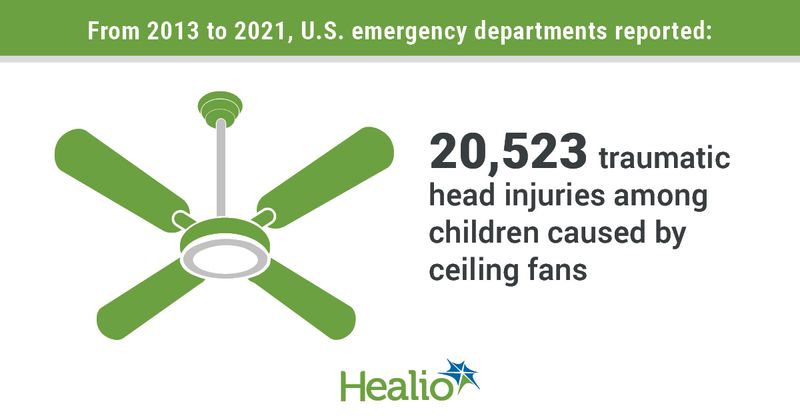Ceiling fan injuries in children uncommon but preventable, study finds
Click Here to Manage Email Alerts
Key takeaways:
- From 2013 to 2021, EDs saw an average of 2,300 pediatric injuries due to ceiling fans per year.
- Infants and toddlers were more likely than older children to be injured being lifted by an adult.
Emergency departments in the United States treated more than 2,000 pediatric injuries caused by ceiling fans per year during a recent 9-year period, according to a study, which determined that the injuries were uncommon but preventable.
“We're the only pediatric Level 1 trauma center in in the central Texas area,” Holly Hughes-Garza, DVM, MPH, an epidemiologist at Dell Children's Trauma and Injury Research Center in Austin, told Healio.

“As a research center, we're all about learning as much as we can about how kids get injured in our community and how we can prevent those injuries,” Hughes-Garza said. “A lot of our research ideas come out of kids that we've actually seen who are injured.”
Hughes-Garza said a colleague once treated a child with a severe head injury caused by a ceiling fan, which prompted them to investigate how much has been published about such injuries.
“We discovered that there really wasn't very much out there,” Hughes-Garza said. “There's a few studies published from outside the U.S. from countries like Australia and Iraq, but nobody had really looked at it in the U.S.”
Hughes-Garza and colleagues studied data from the Consumer Product Safety Commission’s National Electronic Injury Surveillance System database on injuries treated in EDs across the country.
“Using their online query tool, we were able to find all the cases of kids who went to an emergency room, or received an injury from a fan,” Hughes-Garza said.
The authors read through case narratives from 640 records in the database to determine which injuries were caused by fans, and found that there were approximately 2,300 pediatric head injuries from contact with ceiling fans per year from 2013 to 2021, totaling 20,523 over the years.
“I'm a parent, and we all try to keep our kids safe and keep them from getting hurt,” Hughes-Garza said. “When you read these case descriptions, they're all very relatable. The same scenarios come up over and over and over again, and accidents happen all the time, unfortunately. But I think just seeing through the similarities and how they happen really stuck with me.”
Common scenarios included infants and toddlers being lifted into the air by an adult and hitting their head, and older children jumping off of a piece of furniture, usually a bunk bed or loft bed. Lacerations were the most common injury, with skull or facial fractures being rarely reported.
According to Hughes-Garza, most of the injuries were not severe.
“The majority of them were like, a kid goes to the emergency room because they have a laceration or a big cut that might need stitches from the fan,” Hughes-Garza said. “Very rarely, we see some more serious injuries like skull fractures and concussions. And so, I think it's important for pediatricians to be aware that those things can happen, even though they're rare.”
She said there is not enough information to know if the size, type or speed of a fan blade makes a difference in the seriousness of the injury, but that, “for whatever reason, every once in a while [it] causes a really serious injury. I’d like to know more.”
“I think it's important to think about, how can we help prevent these injuries from happening?” Hughes-Garza said. “Certainly, for the older kids, we want to try to keep furniture, especially a bunk bed, away from a ceiling fan as much as we can to reduce that risk.”
